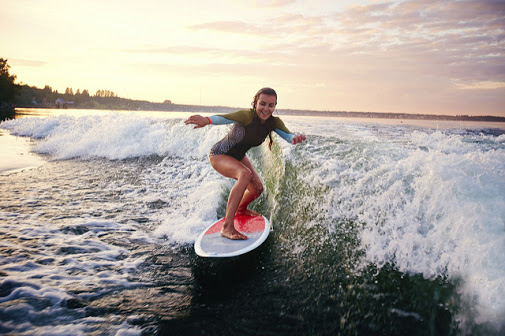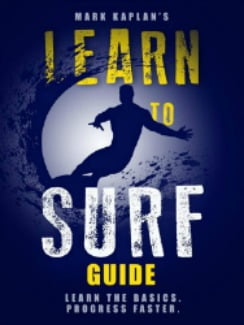Surfers Transition from Foam to Real Waves
Surfers transition from foam to real waves with practice, frequent surfing, and learning techniques. Beginner surfers start with foam waves and then learn to paddle out to larger foam waves.
When surfing larger foam waves feels comfortable, the surfer can begin with small real waves. The hidden element here is courage. Each step to bigger waves involves managing fear.

Techniques to Transition from Foam to Real Waves
Timing is the first element of catching waves. With foam waves, the surfer sees the wave break and then form a nice straight line of foam toward the beach. With a real wave, better timing is required because the wave only arcs for a few seconds.
The surfer needs to be close to where the waves arc. This will vary on reefs and sand bar beaches. In reefs, the underwater formation that makes the waves break is always in the same place so the waves should break in the same place.
With foam waves, the bottom shifts continuously so the point of break shifts all day and most every day with swell directions, currents, and tide all influencing what happens to the bottom.
One indication of where a real wave will break is where other surfers are sitting. They have different boards and might want different waves, but they are close to where the waves break. The surfer looks at where they are and watches where the waves are breaking.
The surfer sits on his board or paddles where the waves break to hunt them. The advantage of moving a little is that the surfer has some momentum when the wave starts to form. Then the surfer decides whether he has to paddle out, parallel, or in to catch the wave.
A surfer lets the real wave roll under the surfboard. Then he paddles hard to catch it with just three or four paddles. He puts his hands on the board and pops up. The surfer wants to watch which way the wave is breaking and head towards the pocket. He can also ride down the face and then bottom turn into the pocket.
Once again, courage is a big factor and when the board is heading down the face, it is going faster than the surfer is used to and he is also afraid of pearling. A surfer has to laugh off the wipe outs or he won’t want to continue. No one enjoys them, but they are part of learning.
Learn More
My New Surfing Course in an E-Book plus Demo Video or Audio Version
Get the 18 Chapter, 7,500 word Course that can prepare you for a lesson or give you the fundamentals if you are going to try it on your own. 10 years of teaching 350 students a year has given me the insights on the most precise measures you must follow for success. This course is what I teach on the dry land and in water instruction. The Course includes a 15 minute video on my dry land and in water demonstration. Only $4.95
Buy the E-Book and start learning $2.99. Learn to Surf
Buy the Paperback on Amazon $7.95
Get Learn to Surf Course in 29 minute AUDIO. Great prep for a lesson, reviewing after a lesson, learning on your own, refreshing after not having surfed for a while. See Table of Contents. Only $7.95.

For Oceanside Surf Lessons, see the Home Page
See the Post Search Lessons Teach Fundamentals
See the Post Catching Real Surf Waves
See my Dry Land and in Water Demo video
See my other Surf site for more Posts
I have lowered the price of Courses and Books for the lock down price of $2.99
80 page Learn to Surf Book
![Surf Instructions Beginner to Advanced: Learn to Ride Waves by [Kaplan, Mark]](https://images-na.ssl-images-amazon.com/images/I/51HswFtoBQL.jpg)